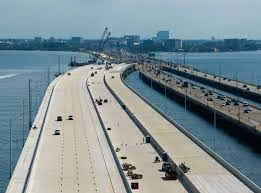Florida officials marked a milestone in the state’s largest transportation project in Tampa Bay with the opening of the new Howard Frankland Bridge and the beginning of demolition of its oldest span.
The achievement was hailed by Governor Ron DeSantis in a press conference at Tampa International Airport as the cornerstone of Florida’s dedication to building better infrastructure.
“Today, I was pleased to announce significant developments on two major infrastructure projects in the Tampa Bay area: the new Howard Frankland Bridge and Pinellas County’s I-275 Moving Florida Forward project,” DeSantis stated. “Our Moving Florida Forward Initiative is bringing major improvements years ahead of schedule, reducing travel time for families and businesses, and making long-term investments that will benefit Florida’s growth for generations to come.”
The New Bridge
The $865 million new span, opened to traffic this summer, raises Tampa Bay capacity by 50 percent. Constructed to today’s building standards, the bridge is designed to withstand hurricane forces and connects directly to the newly finished Gateway Expressway and I-275 Express project.
The new bridge has express and general-purpose lanes, giving drivers more travel option and relieving the route from Tampa to St. Petersburg. A bicycle and pedestrian path will open in 2026, producing another non-vehicle link across the bay.
The new bridge was built by Archer Western Construction, part of The Walsh Group, which served as the lead contractor on the project.
Demolition of the Old Span
With traffic flowing on the new bridge, work crews began disassembling the original Howard Frankland Bridge, which was opened in 1959. Removal of the old structure will make the channel safer for mariners and finish the transition to the new span.
FDOT Secretary Jared W. Perdue, P.E., said: “Our crews are moving quickly to demolish the old Howard Frankland Bridge while advancing on projects that will redefine the region’s mobility for generations.”
Part of Moving Florida Forward
The replacement of the Howard Frankland Bridge is FDOT’s District 7’s biggest transportation project in history and the centerpiece of Florida’s Moving Florida Forward program. In 2023, the initiative is charging ahead on more than 20 congestion-relief projects statewide, years ahead of expectations.
Since its inception, the Florida Legislature has invested around $7 billion in state reserves to accelerate such projects as the Howard Frankland and I-275 widening, and more than $68 billion will be invested in transportation improvements over the next five years to maintain infrastructure in line with the needs of residents, tourists, and companies.
Howard Frankland Bridge Replacement Project Factsheet
Project Overview
Major Milestone Achieved: The new Howard Frankland Bridge is now complete and operational, with demolition of the original 1959 span officially underway. This marks the completion of Florida’s largest transportation investment in the Tampa Bay region and a significant milestone in the state’s infrastructure modernization efforts.
Key Project Details
Total Investment: $865 million
Capacity Enhancement: 50% increase in capacity across Tampa Bay
Historical Context: Replacing the original bridge that opened in 1959
New Bridge Features
Design Standards:
Engineered to withstand hurricanes
Modern construction meeting current safety and durability requirements
Enhanced capacity for both current and future traffic demands
Traffic Configuration:
General-purpose lanes for regular traffic
Express lanes for faster travel
Direct connections to Gateway Expressway and I-275 Express project
Multi-Modal Access:
Pedestrian and bicycle path scheduled to open in 2026
First non-vehicular link across Tampa Bay via the Howard Frankland corridor
Demolition Phase – Now Underway
Demolition of the original Howard Frankland Bridge has officially begun following the successful transition of all traffic to the new span.
Current Activity: Active dismantling of the 66-year-old bridge structure (opened 1959)
Maritime Benefits: Removal will improve safety in the shipping channel
Significance: Marks the final phase of the largest transportation project in FDOT District 7 history
Program Context: Moving Florida Forward Initiative:
Launched in 2023
Expediting 20+ congestion-relief projects statewide
Delivering projects years ahead of original schedules
District Recognition: Largest transportation project ever completed by FDOT District 7
Funding & Investment
State Commitment:
$7 billion allocated from state reserves for Moving Florida Forward projects
$68 billion committed for transportation improvements over next five years
Combined with I-275 Express Lanes: $1.3+ billion regional investment
Regional Impact
Connectivity Improvements:
Enhanced mobility between Tampa and St. Petersburg
Reduced congestion on critical cross-bay corridor
Strengthened hurricane evacuation route capacity
Economic Impact:
Support for regional economic growth
Improved access for residents, visitors, and businesses
Long-term infrastructure investment supporting Florida’s growth

